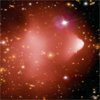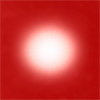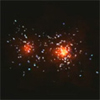CXC Home | Search | Help | Image Use Policy | Latest Images | Privacy | Accessibility | Glossary | Q&A
Images of the Bullet Cluster
Quicktime MPEG
This view of the Bullet Cluster is a combination of X-rays from Chandra (red) and optical data from the Hubble and Magellan telescope (yellow). Scientists have examined this system with Chandra and Compton to look for evidence of antimatter in the cluster's hot gas. The results did not reveal the signature for the collision of matter and antimatter, meaning that there is little or no antimatter in the Bullet Cluster, at most 3 parts per million. The X-ray emission shows the amount of hot gas in this system.
[Runtime: 00:11]
Quicktime MPEG
This view of the Bullet Cluster is a combination of X-rays from Chandra (red) and optical data from the Hubble and Magellan telescope (yellow). Scientists have examined this system with Chandra and Compton to look for evidence of antimatter in the cluster's hot gas. The results did not reveal the signature for the collision of matter and antimatter, meaning that there is little or no antimatter in the Bullet Cluster, at most 3 parts per million. The X-ray emission shows the amount of hot gas in this system.
[Runtime: 00:11]
(Credit: X-ray: NASA/CXC/CfA/M.Markevitch et al.; Optical: NASA/STScI; Magellan/U.Arizona/D.Clowe et al.)
Illustration of Antimatter/Matter Annihilation
Quicktime MPEG
Antimatter is made up of elementary particles that have the same masses as their corresponding matter counterparts but the opposite charges and magnetic properties. This illustration shows what happens when a particle of antimatter collides with one of matter. The particles annihilate each other and produce energy according to Einstein's famous equation, E=mc2, mostly in the form of gamma rays, which scientists are looking for using the Compton observatory. Secondary particles are also produced. This annihilation has not been seen in the Bullet Cluster.
[Runtime: 00:15]
Quicktime MPEG
Antimatter is made up of elementary particles that have the same masses as their corresponding matter counterparts but the opposite charges and magnetic properties. This illustration shows what happens when a particle of antimatter collides with one of matter. The particles annihilate each other and produce energy according to Einstein's famous equation, E=mc2, mostly in the form of gamma rays, which scientists are looking for using the Compton observatory. Secondary particles are also produced. This annihilation has not been seen in the Bullet Cluster.
[Runtime: 00:15]
(Credit: NASA/CXC/M. Weiss)
Animation of Galaxy Cluster
Quicktime MPEG
This animation shows a galaxy cluster, the largest gravitationally-bound objects in the Universe. Two of these mammoth objects collided to create the system that astronomers call the Bullet Cluster, officially known as 1E 0657-56. Individual galaxies are shown in white and yellow, and the intergalactic gas is shown in red. Galaxy clusters contain as much mass as a million billion suns. The strong gravitational pull of this matter squeezes the gas and heats it to about 100 million degrees, making it only detectable in X-rays.
[Runtime: 00:38]
Quicktime MPEG
This animation shows a galaxy cluster, the largest gravitationally-bound objects in the Universe. Two of these mammoth objects collided to create the system that astronomers call the Bullet Cluster, officially known as 1E 0657-56. Individual galaxies are shown in white and yellow, and the intergalactic gas is shown in red. Galaxy clusters contain as much mass as a million billion suns. The strong gravitational pull of this matter squeezes the gas and heats it to about 100 million degrees, making it only detectable in X-rays.
[Runtime: 00:38]
(Credit: NASA/CXC/A.Hobart)
Return to Bullet Cluster (October 30, 2008)





